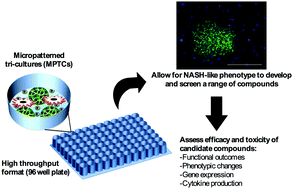Microengineered cultures containing human hepatic stellate cells and hepatocytes for drug development†
Abstract
In non-alcoholic steatohepatitis (NASH), hepatic stellate cells (HSC) differentiate into myofibroblast-like cells that cause fibrosis, which predisposes patients to cirrhosis and hepatocellular carcinoma. Thus, modeling interactions between activated HSCs and hepatocytes in vitro can aid in the development of anti-NASH/fibrosis therapeutics and lead to a better understanding of disease progression. Species-specific differences in drug metabolism and disease pathways now necessitate the supplementation of animal studies with data acquired using human liver models; however, current models do not adequately model the negative effects of primary human activated HSCs on the phenotype of otherwise well-differentiated primary human hepatocytes (PHHs) as in vivo. Therefore, here we first determined the long-term effects of primary human activated HSCs on PHH phenotype in a micropatterned co-culture (MPCC) platform while using 3T3-J2 murine embryonic fibroblasts as the control cell type since it has been shown previously to stabilize PHH functions for 4–6 weeks. We found that HSCs were not able to stabilize the PHH phenotype to the same magnitude and longevity as the fibroblasts, which subsequently inspired the development of a micropatterned tri-culture (MPTC) platform in which (a) micropatterned PHHs were functionally stabilized using fibroblasts, and (b) the PHH phenotype was modulated by culturing HSCs within the fibroblast monolayer at physiologically-relevant ratios with PHHs. Transwell inserts containing HSCs were placed atop MPCCs containing fibroblasts to confirm the effects of paracrine signaling between PHHs and HSCs. We found that while albumin and urea secretions were relatively similar in MPTCs and MPCCs (suggesting well-differentiated PHHs), increasing HSC numbers within MPTCs downregulated hepatic cytochrome-P450 (2A6, 3A4) and transporter activities, and caused steatosis over 2 weeks. Furthermore, MPTCs secreted higher levels of pro-inflammatory interleukin-6 (IL-6) cytokine and C-reactive protein (CRP) than MPCCs. Treatment of MPCCs with HSC-conditioned culture medium confirmed that HSC secretions mediate the altered phenotype of PHHs observed in MPTCs, partly via IL-6 signaling. Lastly, we found that NADPH oxidase (NOX) inhibition and farnesoid X receptor (FXR) activation using clinically relevant drugs alleviated hepatic dysfunctions in MPTCs. In conclusion, MPTCs recapitulate symptoms of NASH- and early fibrosis-like dysfunctions in PHHs and have utility for drug discovery in this space.



 Please wait while we load your content...
Please wait while we load your content...